Jireh Jam
V-LinkNet: Learning Contextual Inpainting Across Latent Space of Generative Adversarial Network
Jan 02, 2022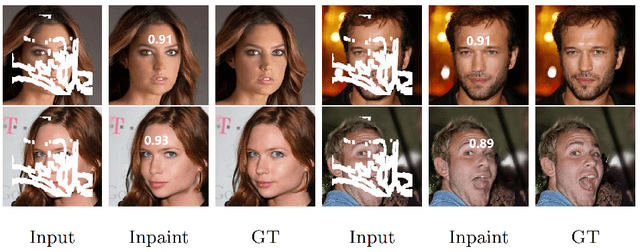

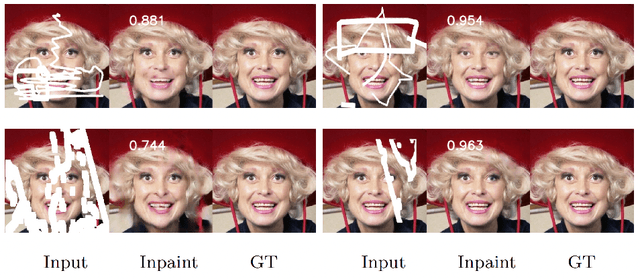

Abstract:Deep learning methods outperform traditional methods in image inpainting. In order to generate contextual textures, researchers are still working to improve on existing methods and propose models that can extract, propagate, and reconstruct features similar to ground-truth regions. Furthermore, the lack of a high-quality feature transfer mechanism in deeper layers contributes to persistent aberrations on generated inpainted regions. To address these limitations, we propose the V-LinkNet cross-space learning strategy network. To improve learning on contextualised features, we design a loss model that employs both encoders. In addition, we propose a recursive residual transition layer (RSTL). The RSTL extracts high-level semantic information and propagates it down layers. Finally, we compare inpainting performance on the same face with different masks and on different faces with the same masks. To improve image inpainting reproducibility, we propose a standard protocol to overcome biases with various masks and images. We investigate the V-LinkNet components using experimental methods. Our result surpasses the state of the art when evaluated on the CelebA-HQ with the standard protocol. In addition, our model can generalise well when evaluated on Paris Street View, and Places2 datasets with the standard protocol.
FacialGAN: Style Transfer and Attribute Manipulation on Synthetic Faces
Oct 18, 2021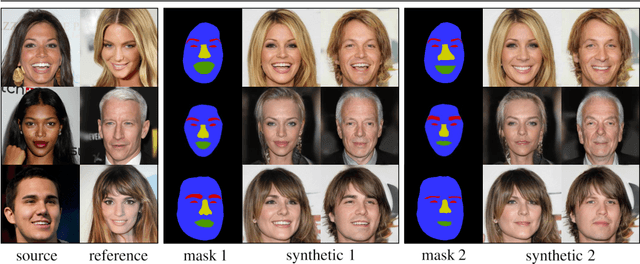

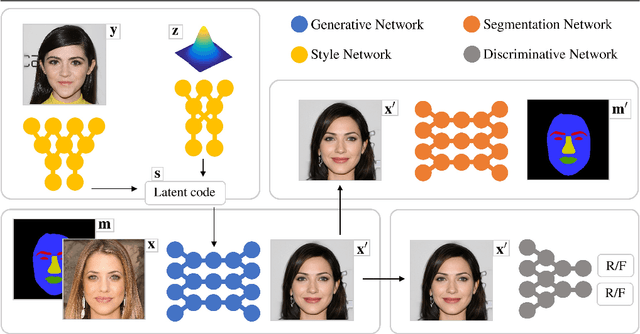
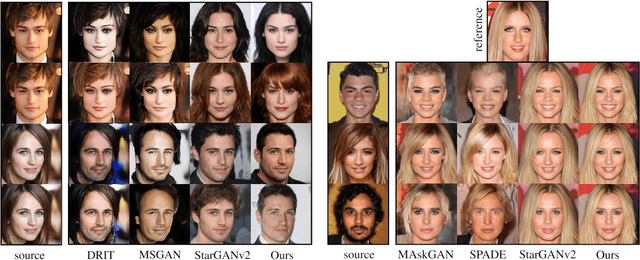
Abstract:Facial image manipulation is a generation task where the output face is shifted towards an intended target direction in terms of facial attribute and styles. Recent works have achieved great success in various editing techniques such as style transfer and attribute translation. However, current approaches are either focusing on pure style transfer, or on the translation of predefined sets of attributes with restricted interactivity. To address this issue, we propose FacialGAN, a novel framework enabling simultaneous rich style transfers and interactive facial attributes manipulation. While preserving the identity of a source image, we transfer the diverse styles of a target image to the source image. We then incorporate the geometry information of a segmentation mask to provide a fine-grained manipulation of facial attributes. Finally, a multi-objective learning strategy is introduced to optimize the loss of each specific tasks. Experiments on the CelebA-HQ dataset, with CelebAMask-HQ as semantic mask labels, show our model's capacity in producing visually compelling results in style transfer, attribute manipulation, diversity and face verification. For reproducibility, we provide an interactive open-source tool to perform facial manipulations, and the Pytorch implementation of the model.
Foreground-guided Facial Inpainting with Fidelity Preservation
May 07, 2021



Abstract:Facial image inpainting, with high-fidelity preservation for image realism, is a very challenging task. This is due to the subtle texture in key facial features (component) that are not easily transferable. Many image inpainting techniques have been proposed with outstanding capabilities and high quantitative performances recorded. However, with facial inpainting, the features are more conspicuous and the visual quality of the blended inpainted regions are more important qualitatively. Based on these facts, we design a foreground-guided facial inpainting framework that can extract and generate facial features using convolutional neural network layers. It introduces the use of foreground segmentation masks to preserve the fidelity. Specifically, we propose a new loss function with semantic capability reasoning of facial expressions, natural and unnatural features (make-up). We conduct our experiments using the CelebA-HQ dataset, segmentation masks from CelebAMask-HQ (for foreground guidance) and Quick Draw Mask (for missing regions). Our proposed method achieved comparable quantitative results when compare to the state of the art but qualitatively, it demonstrated high-fidelity preservation of facial components.
R-MNet: A Perceptual Adversarial Network for Image Inpainting
Aug 11, 2020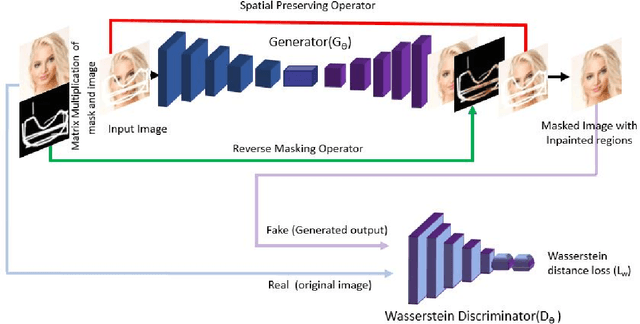
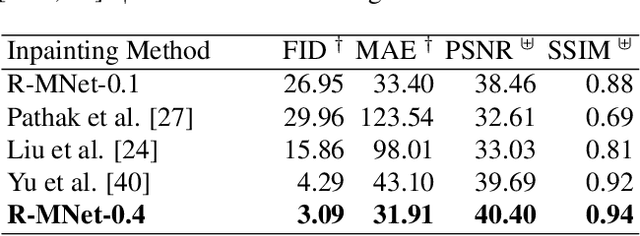
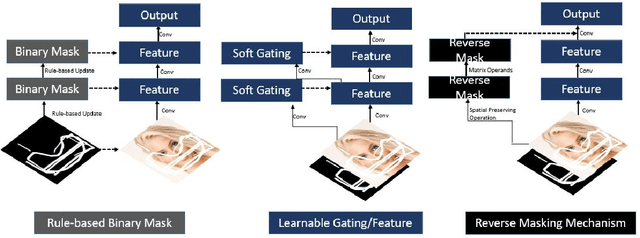

Abstract:Facial image inpainting is a problem that is widely studied, and in recent years the introduction of Generative Adversarial Networks, has led to improvements in the field. Unfortunately some issues persists, in particular when blending the missing pixels with the visible ones. We address the problem by proposing a Wasserstein GAN combined with a new reverse mask operator, namely Reverse Masking Network (R-MNet), a perceptual adversarial network for image inpainting. The reverse mask operator transfers the reverse masked image to the end of the encoder-decoder network leaving only valid pixels to be inpainted. Additionally, we propose a new loss function computed in feature space to target only valid pixels combined with adversarial training. These then capture data distributions and generate images similar to those in the training data with achieved realism (realistic and coherent) on the output images. We evaluate our method on publicly available dataset, and compare with state-of-the-art methods. We show that our method is able to generalize to high-resolution inpainting task, and further show more realistic outputs that are plausible to the human visual system when compared with the state-of-the-art methods.
Symmetric Skip Connection Wasserstein GAN for High-Resolution Facial Image Inpainting
Jan 11, 2020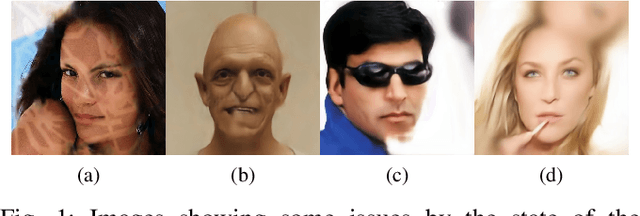
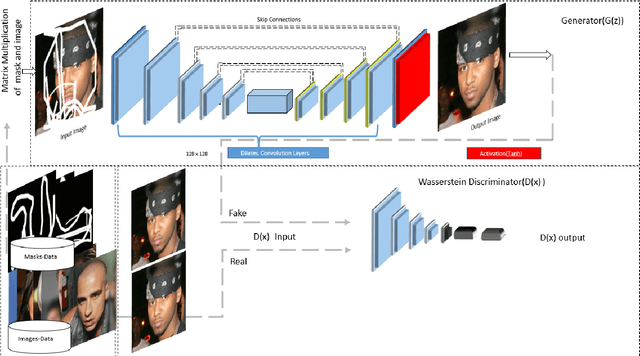

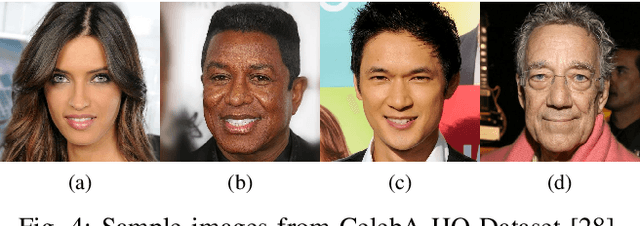
Abstract:We propose a Symmetric Skip Connection Wasserstein Generative Adversarial Network (S-WGAN) for high-resolution facial image inpainting. The architecture is an encoder-decoder with convolutional blocks, linked by skip connections. The encoder is a feature extractor that captures data abstractions of an input image to learn an end-to-end mapping from an input (binary masked image) to the ground-truth. The decoder uses the learned abstractions to reconstruct the image. With skip connections, S-WGAN transfers image details to the decoder. Also, we propose a Wasserstein-Perceptual loss function to preserve colour and maintain realism on a reconstructed image. We evaluate our method and the state-of-the-art methods on CelebA-HQ dataset. Our results show S-WGAN produces sharper and more realistic images when visually compared with other methods. The quantitative measures show our proposed S-WGAN achieves the best Structure Similarity Index Measure of 0.94.
 Add to Chrome
Add to Chrome Add to Firefox
Add to Firefox Add to Edge
Add to Edge